榧树(Torreya grandis)是裸子植物红豆杉科(Taxaceae)榧属(Torreya Arn.)常绿乔木,在我国有1300多年的栽培历史。榧树种仁含油率为42.67%~61.47%,不饱和脂肪酸含量可达80%,蛋白质含量10%左右,含有7种人体必需氨基酸,富含钾、镁、钙和锌等矿质元素[1-6],不仅营养价值高,而且还有抗菌、镇咳以及抗肿瘤的作用[7-10],具有较大的经济价值和开发潜力。香榧(T.grandis‘Merrillii’)是目前主栽的、经人工选育及嫁接繁育栽培得到的优良榧树品种[11]。
近年来,我国香榧产业发展规模不断扩大,香榧产量不断提升,栽培立地类型趋向多样化,人们对高品质香榧的栽培和生产需求越来越高。果实内含物营养成分是果实高品质形成的基础[12]。长期以来,研究者从营养管理、土壤条件和产量调控等方面对高品质香榧的培育和生产开展了大量研究。李瑞芳[13]和黄其颖等[14]研究了微量元素肥对香榧种仁品质的影响;戴文圣等[15]研究发现土壤中的钙元素含量与香榧中的钙、铁、氮元素含量呈显著相关,是影响香榧品质的重要因素;孙小红等[16]基于坚果大小、油脂含量和组成、蛋白质含量等指标对绍兴地区香榧坚果的品质进行了综合评价,结果表明不同产地香榧的综合品质差异较大;此外,也有研究认为,黄泥土最利于香榧的生长[17]。可见,营养管理、产区生态和土壤条件是影响其品质形成的重要因素。然而,香榧分布区的栽培立地土壤类型多样,大面积的香榧栽植于火山灰土、花岗岩风化土、砂土、黄泥土和石灰岩土等不同类型的土壤中,不同母岩发育土壤对香榧种仁品质的影响仍不清楚。基于此,笔者在本研究中以浙江省典型的香榧栽培林地为对象,分析了5种母岩发育土壤的养分特征及其与香榧品质性状的关系,基于灰色系统关联度分析法对香榧种仁含油率和蛋白质、水解氨基酸、淀粉、可溶性糖、矿质元素和维生素E含量等品质性状以及炒制加工风味进行综合评价,以期为高品质香榧的栽培和生产提供借鉴和参考。
1 材料和方法
1.1 试验时间和地点
试验在浙江省杭州市临安区和富阳区、金华东阳市和绍兴诸暨市的香榧种植基地进行(表1),室内试验在中国林业科学研究院亚热带林业研究所进行。
表1 不同土壤类型香榧林的分布情况
Table 1 Soil types in the T.grandis plantations
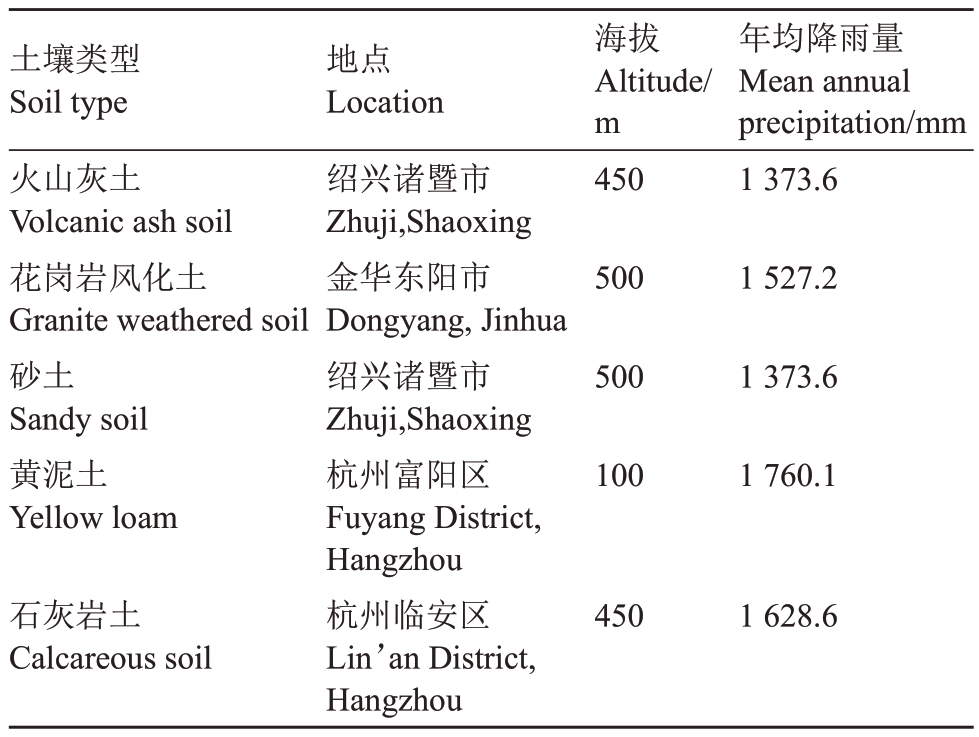
土壤类型Soil type火山灰土Volcanic ash soil花岗岩风化土Granite weathered soil砂土Sandy soil黄泥土Yellow loam石灰岩土Calcareous soil地点Location绍兴诸暨市Zhuji,Shaoxing金华东阳市Dongyang,Jinhua绍兴诸暨市Zhuji,Shaoxing杭州富阳区Fuyang District,Hangzhou杭州临安区Lin’an District,Hangzhou海拔Altitude/m 450 500 500 100 450年均降雨量Mean annual precipitation/mm 1 373.6 1 527.2 1 373.6 1 760.1 1 628.6
1.2 试验材料
各土壤类型种植的香榧(T.grandis‘Merrillii’)树龄为15~20 a,正常管理,选取生长良好、无病虫害、生长势相对一致的代表性植株为样株。
1.3 试验方法
1.3.1 种仁品质指标的测定 2020 年9 月,于果实充分成熟时取样,在树冠不同方位随机采30个果,3次重复。参照GB 5009.6—2016 索氏抽提法[18]测定种仁含油率;参照GB 5009.82—2016 正相高效液相色谱法[19]测定种仁维生素E 含量;参照GB 5009.124—2016用氨基酸自动分析仪测定种仁水解氨基酸含量[20];参照GB 5009.5—2016凯氏定氮法[21]测定种仁蛋白质含量;采用蒽酮比色法测定淀粉和可溶性糖的含量;参照GB 5009.268—2016 电感耦合等离子体质谱法(ICP-MS)[22]测定种仁中锰、铁、锌元素含量,利用电感耦合等离子体发射光谱法(ICP-OES)测定种仁中钾、钙、镁元素含量。
1.3.2 香榧加工风味品质的评价 从典型植株上取25 kg充分成熟的种子,进行统一后熟、炒制和加工,遴选15 名专业人员对香榧种仁的风味感官进行评价,各指标及标准分值如下:咬感(35 分)、香味(20分)、甜味(20分)、肉质细腻程度(25分)。各加工风味指标的得分以平均值表示。
1.3.3 土壤养分的测定 采用随机定点法进行土壤取样,以树冠外沿为取样区域,去除表土,用环刀采集土壤表层(0~20 cm)样品,每个样品由3~5个取样点混合而成。参照LY/T 1239—1999 电位法[23]测定土壤的pH值;参照LY/T 1228—2015碱解-扩散法[24]测定土壤水解性氮含量;参照LY/T 1232—2015碳酸氢钠浸提法[25]测定土壤有效磷含量;参照LY/T 1234—2015 火焰光度法[26]测定土壤速效钾含量;参照LY/T 1237—1999 重铬酸钾氧化-外加热法[27]测定土壤有机质含量;参照NY/T 296—1995原子吸收分光光度法[28]测定土壤镁、钙元素含量;采用重铬酸钾法测定土壤铁元素含量;参照HJ491—2019火焰原子吸收分光光度法[29]测定土壤锌元素含量。
1.4 统计分析
采用灰色关联度分析法[30]对种仁品质进行综合评价;数据采用Microsoft Excel 2003 软件和SPSS 19.0进行统计分析并作图。
2 结果与分析
2.1 不同土壤类型的差异分析
香榧产区各土壤类型的营养水平明显不同。如表2 所示,5 个土壤类型的pH 值在5.05~7.62 之间,变异系数为19.02%;花岗岩风化土、黄泥土和砂土偏酸性,pH 值较低;石灰岩土呈弱碱性,pH 值较高。土壤有机质以及水解性氮、有效磷、速效钾、锌、钙、镁、锰和铁元素的平均含量(w)分别为31.60 g·kg-1、180.14 mg·kg-1、233.67 mg·kg-1、214.84 mg·kg-1、12.31 g·kg-1、9.46 g·kg-1、0.74 g·kg-1、40.98 g·kg-1和115.40 mg·kg-1,变异系数在39.68%~177.20%之间。主成分分析结果如图1 所示,各土壤类型的养分特征差异较大,说明香榧对土壤的适应性较强。进一步分析了土壤各特征指标间的相关性,结果如表3所示,土壤pH值与镁元素含量呈极显著正相关(p <0.01),与钙、锌元素含量呈显著正相关(p <0.05);有机质含量与水解性氮含量、钙含量与镁元素含量、镁含量与锌元素含量、锰含量与锌元素含量分别呈显著正相关(p <0.05)。

图1 不同土壤类型主成分分析
Fig.1 Principal component analysis of different soil types
表2 不同类型土壤的营养特征
Table 2 Nutrients status of different types of soil
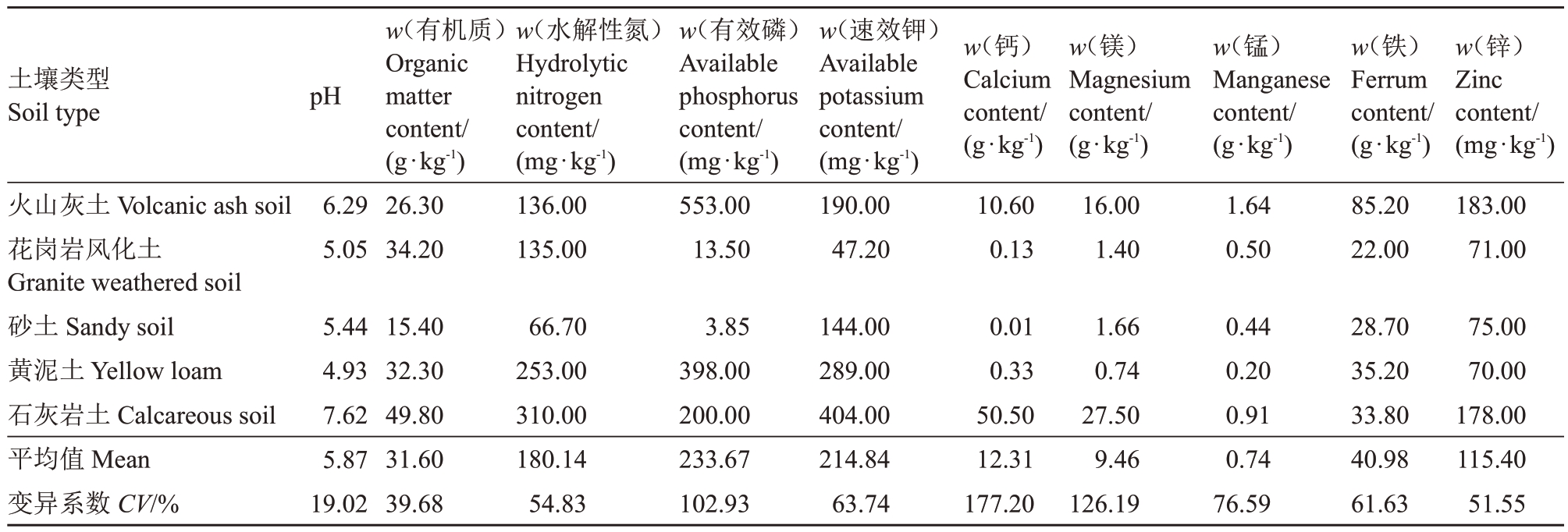
土壤类型Soil type火山灰土Volcanic ash soil花岗岩风化土Granite weathered soil砂土Sandy soil黄泥土Yellow loam石灰岩土Calcareous soil平均值Mean变异系数CV/%pH 6.29 5.05 5.44 4.93 7.62 5.87 19.02 w(有机质)Organic matter content/(g·kg-1)26.30 34.20 15.40 32.30 49.80 31.60 39.68 w(水解性氮)Hydrolytic nitrogen content/(mg·kg-1)136.00 135.00 66.70 253.00 310.00 180.14 54.83 w(有效磷)Available phosphorus content/(mg·kg-1)553.00 13.50 3.85 398.00 200.00 233.67 102.93 w(速效钾)Available potassium content/(mg·kg-1)190.00 47.20 144.00 289.00 404.00 214.84 63.74 w(钙)Calcium content/(g·kg-1)10.60 0.13 0.01 0.33 50.50 12.31 177.20 w(镁)Magnesium content/(g·kg-1)16.00 1.40 1.66 0.74 27.50 9.46 126.19 w(锰)Manganese content/(g·kg-1)1.64 0.50 0.44 0.20 0.91 0.74 76.59 w(铁)Ferrum content/(g·kg-1)85.20 22.00 28.70 35.20 33.80 40.98 61.63 w(锌)Zinc content/(mg·kg-1)183.00 71.00 75.00 70.00 178.00 115.40 51.55
表3 不同土壤类型各养分指标间的相关性分析
Table 3 Correlation analysis between nutrients indicators of different soil types
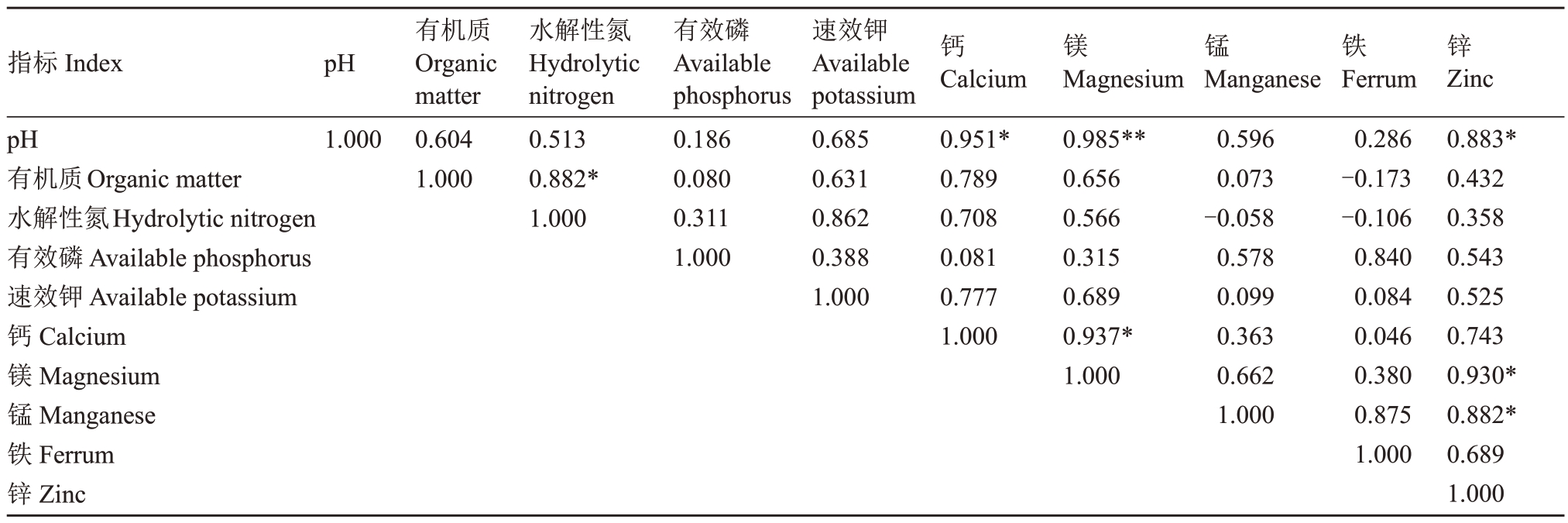
注:*表示显著相关,**表示极显著相关。下同。
Note:*indicates significant correlation,**indicates extremely significant correlation.The same below.
指标Index pH有机质Organic matter水解性氮Hydrolytic nitrogen有效磷Available phosphorus速效钾Available potassium钙Calcium镁Magnesium锰Manganese铁Ferrum锌Zinc pH 1.000有机质Organic matter 0.604 1.000水解性氮Hydrolytic nitrogen 0.513 0.882*1.000有效磷Available phosphorus 0.186 0.080 0.311 1.000速效钾Available potassium 0.685 0.631 0.862 0.388 1.000钙Calcium 0.951*0.789 0.708 0.081 0.777 1.000镁Magnesium 0.985**0.656 0.566 0.315 0.689 0.937*1.000锰Manganese 0.596 0.073-0.058 0.578 0.099 0.363 0.662 1.000铁Ferrum 0.286-0.173-0.106 0.840 0.084 0.046 0.380 0.875 1.000锌Zinc 0.883*0.432 0.358 0.543 0.525 0.743 0.930*0.882*0.689 1.000
2.2 不同土壤类型栽培的香榧种仁品质性状差异分析
种仁含油率和蛋白质、水解氨基酸、淀粉和可溶性糖含量是形成香榧风味的重要性状。如表4 所示,不同土壤类型的香榧种仁含油率和蛋白质和水解氨基酸平均含量(w)分别为59.56%、12.20 g·100 g-1和11.96 g·100 g-1,变异系数在3.42%~5.44%之间,其中黄泥土栽培的香榧种仁含油率最高,石灰岩土栽培的香榧种仁蛋白质和氨基酸含量最高;淀粉和可溶性糖平均含量分别为4.97、3.36 g·100 g-1,变异系数分别为13.91%和13.38%,其中石灰岩土栽培的香榧种仁淀粉和可溶性糖含量最高,砂土最低。
表4 不同土壤类型香榧种仁的品质性状
Table 4 Kernel quality traits of T.grandis from different soil types

种仁品质性状Quality traits风味指标Flavor indicators内在营养指标Inner nutritional traits种仁含油率Oil content in kernel/%w(蛋白质)Protein content/(g·100 g-1)w(水解氨基酸)Hydrolyzed amino acid content/(g·100 g-1)w(淀粉)Starch content/(g·100 g-1)w(可溶性糖)Soluble sugar content/(g·100 g-1)w(钾)Potassium content/(g·kg-1)w(钙)Calcium content/(g·kg-1)w(镁)Magnesium content/(g·kg-1)w(锰)Manganese content/(mg·kg-1)w(铁)Ferrum content/(mg·kg-1)w(锌)Zinc content/(mg·kg-1)w(维生素E)Vitamin E content/(g·kg-1)土壤类型Soil type火山灰土Volcanic ash soil 60.60±1.28 11.40±0.65 11.29±0.12 4.64±0.98 3.07±0.26 5.52±0.33 0.75±0.05 2.51±0.06 8.99±0.89 37.80±3.20 15.10±0.92 1.13±0.06花岗岩风化土Granite weathered soil 56.70±1.07 12.40±0.83 12.08±0.68 4.94±0.79 3.75±0.82 6.50±0.54 0.44±0.03 2.14±0.08 23.90±1.19 46.80±2.56 17.50±1.03 1.49±0.09砂土Sandy soil 60.70±0.98 12.00±0.75 11.89±1.01 4.02±0.66 2.73±0.24 5.77±0.52 0.42±0.04 2.30±0.25 21.40±0.84 48.40±3.83 19.60±1.67 1.26±0.11黄泥土Yellow loam 61.60±1.01 12.00±0.80 11.70±0.96 5.54±0.47 3.48±0.15 4.40±0.65 0.51±0.03 2.35±0.18 18.90±1.02 42.20±3.22 22.30±2.12 1.12±0.08石灰岩土Calcareous soil 58.20±1.3559.56 13.20±0.66 12.86±0.38 5.73±0.36 3.76±0.18 5.17±0.23 0.61±0.02 2.56±0.23 11.40±1.73 49.90±4.74 18.20±2.88 1.29±0.07平均值Mean 12.20 11.96 4.97 3.36 5.47 0.55 2.37 16.92 45.02 18.54 1.26变异系数CV/%3.42 5.44 4.85 13.91 13.38 14.12 24.93 7.11 38.09 11.02 14.34 11.94差异显著性Significance of difference***************
香榧种仁富含矿质元素和维生素E,是形成香榧内在营养品质的重要因子。从表4 可以看出,香榧种仁钾、镁、钙元素含量较高,平均含量分别达到了5.47、2.37、0.55 g·kg-1;锰、铁、锌元素的平均含量相对较低,分别为16.92、45.02、18.54 mg·kg-1。不同类型土壤栽培的香榧种仁矿质元素含量差异较大,如花岗岩风化土栽培的香榧种仁钾元素含量达到了6.50 g·kg-1,是黄泥土的1.48倍,但其钙、镁元素含量较低,分别为火山灰土的58.67%和85.26%。此外,不同矿质元素含量的变异系数差异也较大,钙、锰元素含量的变异系数较高,镁、铁元素含量的变异系数较低,各矿质元素含量的变异系数平均达18.27%。在活性成分方面,不同类型土壤栽培的香榧种仁维生素E 的平均含量为1.26 g·kg- 1,变异系数为11.94%,其中花岗岩风化土的香榧种仁维生素E 含量最高。
2.3 土壤养分特征与种仁品质性状指标的相关性分析
土壤养分特征指标与种仁品质性状指标的相关性如表5 所示。香榧种仁含油率和蛋白质、水解氨基酸和维生素E含量与土壤各养分指标间无显著相关性;种仁淀粉、可溶性糖含量与土壤有机质含量呈显著正相关,相关系数分别为0.902和0.893;种仁淀粉含量还与土壤水解性氮含量呈显著正相关,相关系数达0.965。此外,种仁矿质元素含量受土壤矿质元素含量的影响较大。如,种仁钙元素含量和土壤有效磷、锰、铁、锌元素含量,以及种仁镁元素含量和土壤速效钾、镁和锌元素含量之间均呈显著正相关;种仁锰元素含量则与土壤镁、锰和锌元素含量呈显著负相关。
表5 土壤养分特征指标与种仁品质性状指标间的相关性分析
Table 5 Correlation analysis between soil nutritional traits and kernel quality traits

指标Index种仁Kernel种仁含油率Oil content in kernel蛋白质Protein水解氨基hydrolyzed amino acid淀粉Starch可溶性糖Soluble sugar钾Potassium钙Calcium镁Magnesium锰Manganese铁Ferrum锌Zinc维生素E Vitamin E土壤Soil pH-0.221 0.515 0.568 0.353 0.208-0.137 0.613 0.835*-0.782 0.237-0.436-0.088有机质Organic matter-0.536 0.783 0.728 0.902*0.893*-0.223 0.267 0.383-0.345 0.301-0.039 0.230水解性氮Hydrolytic nitrogen-0.092 0.627 0.567 0.965**0.717-0.654 0.293 0.530-0.411 0.144 0.293-0.184有效磷Available phosphorus 0.552-0.502-0.533 0.282 0.063-0.599 0.835*0.627-0.740-0.859*-0.189-0.804速效钾Available potassium 0.239 0.481 0.480 0.703 0.289-0.783 0.417 0.806*-0.620 0.131 0.274-0.486钙Calcium-0.323 0.725 0.751 0.576 0.442-0.222 0.452 0.741-0.642 0.391-0.226 0.019镁Magnesium-0.220 0.458 0.495 0.431 0.282-0.173 0.714 0.859*-0.845*0.104-0.483-0.131锰Manganese-0.009-0.290-0.245-0.121-0.164 0.135 0.900*0.642-0.834*-0.499-0.874*-0.271铁Ferrum 0.410-0.638-0.614-0.159-0.354-0.162 0.897*0.596-0.783-0.824*-0.613-0.627锌Zinc-0.055 0.106 0.147 0.238 0.076-0.134 0.902*0.879*-0.954**-0.229-0.666-0.301
2.4 香榧种仁品质的灰色关联度分析
以各性状指标的最优值设定参考样,根据关联分析原则,分别计算风味指标(种仁含油率和蛋白质、水解氨基酸、淀粉、可溶性糖含量)和营养品质指标(矿质元素和维生素E 含量)的等权关联度,关联度越大则表示综合品质越优良。如表6 所示,从风味品质指标来看,砂土栽培的香榧种仁品质最佳(等权关联度值0.839 3),花岗岩风化土栽培的最差(等权关联度值0.574 7);从内在营养品质指标来看,花岗岩栽培最好(等权关联度值0.787 3),火山灰土和黄泥土栽培则相对较差。
表6 不同土壤类型香榧种仁的风味和内在营养品质的灰色关联度分析
Table 6 Grey relation analysis of flavor and inner nutritional quality of T.grandis kernel from different soil types

土壤类型Soil type火山灰土Volcanic ash soil花岗岩风化土Granite weathered soil砂土Sandy soil黄泥土Yellow loam石灰岩土Calcareous soil风味指标Flavor indicators等权关联度Equal weight correlation degree 0.615 2 0.574 7 0.839 3 0.601 2 0.683 2排序Rank 3 5 1 4 2内在营养指标Inner nutritional indicators等权关联度Equal weight correlation degree 0.652 3 0.787 3 0.707 8 0.657 3 0.704 5排序Rank 5 1 2 4 3
进一步对炒制加工后的不同土壤类型栽培香榧籽进行感官评测,结果如表7 所示。灰色关联度分析表明,不同土壤类型栽培的香榧籽在加工后感官风味上明显不同,其中,砂土栽培的香榧籽综合评价最好(加权关联度值0.921 7),花岗岩风化土的综合评价最差(加权关联度值0.799 2),石灰岩土、黄泥土和火山灰土居中。
表7 香榧加工感官品质的灰色关联度分析
Table 7 Grey relation analysis of processing sensory quality of T.grandis
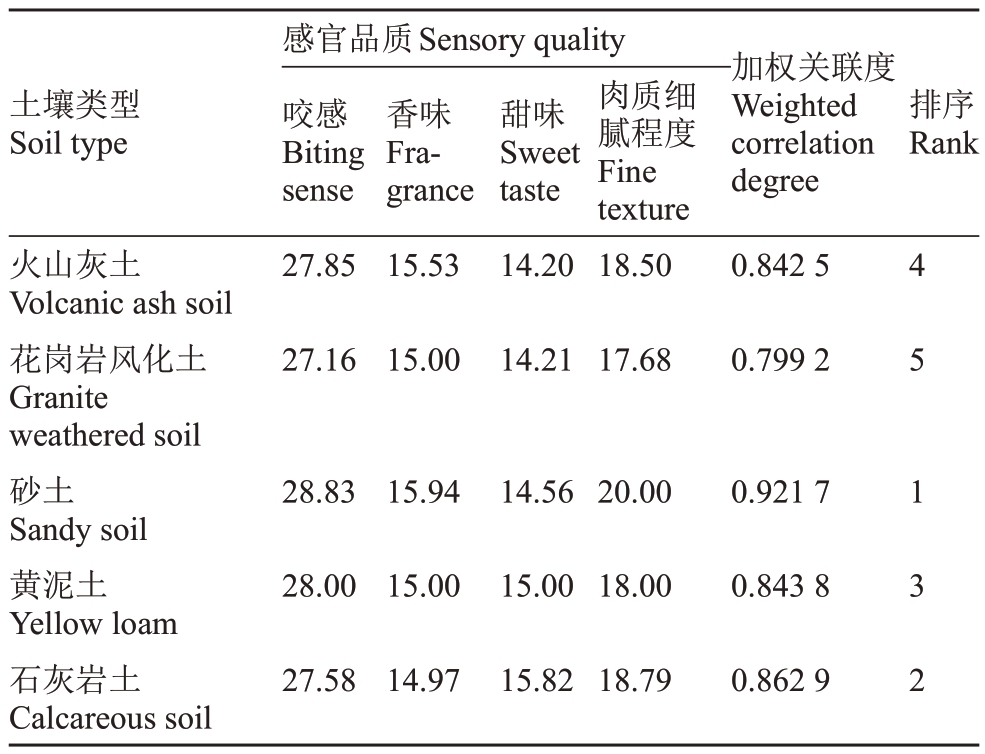
注:各感官风味指标的权重系数为:咬感0.35、香味0.20、甜味0.20、肉质细腻程度0.25。
Note: The weight coefficients of sensory indicators were as follows:biting sense 0.35,Fragrance 0.20,Sweet taste 0.20,Fine texture 0.25.
土壤类型Soil type火山灰土Volcanic ash soil花岗岩风化土Granite weathered soil砂土Sandy soil黄泥土Yellow loam石灰岩土Calcareous soil感官品质Sensory quality咬感Biting sense 27.85 27.16 28.83 28.00 27.58香味Fragrance 15.53 15.00 15.94 15.00 14.97甜味Sweet taste 14.20 14.2117.68 14.5620.00 15.0018.00 15.8218.79肉质细腻程度Fine texture 18.50加权关联度Weighted correlation degree 0.842 5 0.799 2 0.921 7 0.843 8 0.862 9排序Rank 4 5 1 3 2
对风味指标、内在营养指标和加工感官品质的关联度取值进行相关性分析,发现香榧种仁风味指标和加工感官品质呈极显著正相关,相关系数为0.957 5(p <0.01),内在营养指标和加工感官品质间存在负相关关系,相关系数为-0.335 0(p <0.05),而种仁风味指标和内在营养指标(相关系数-0.057)无显著相关性(图2)。
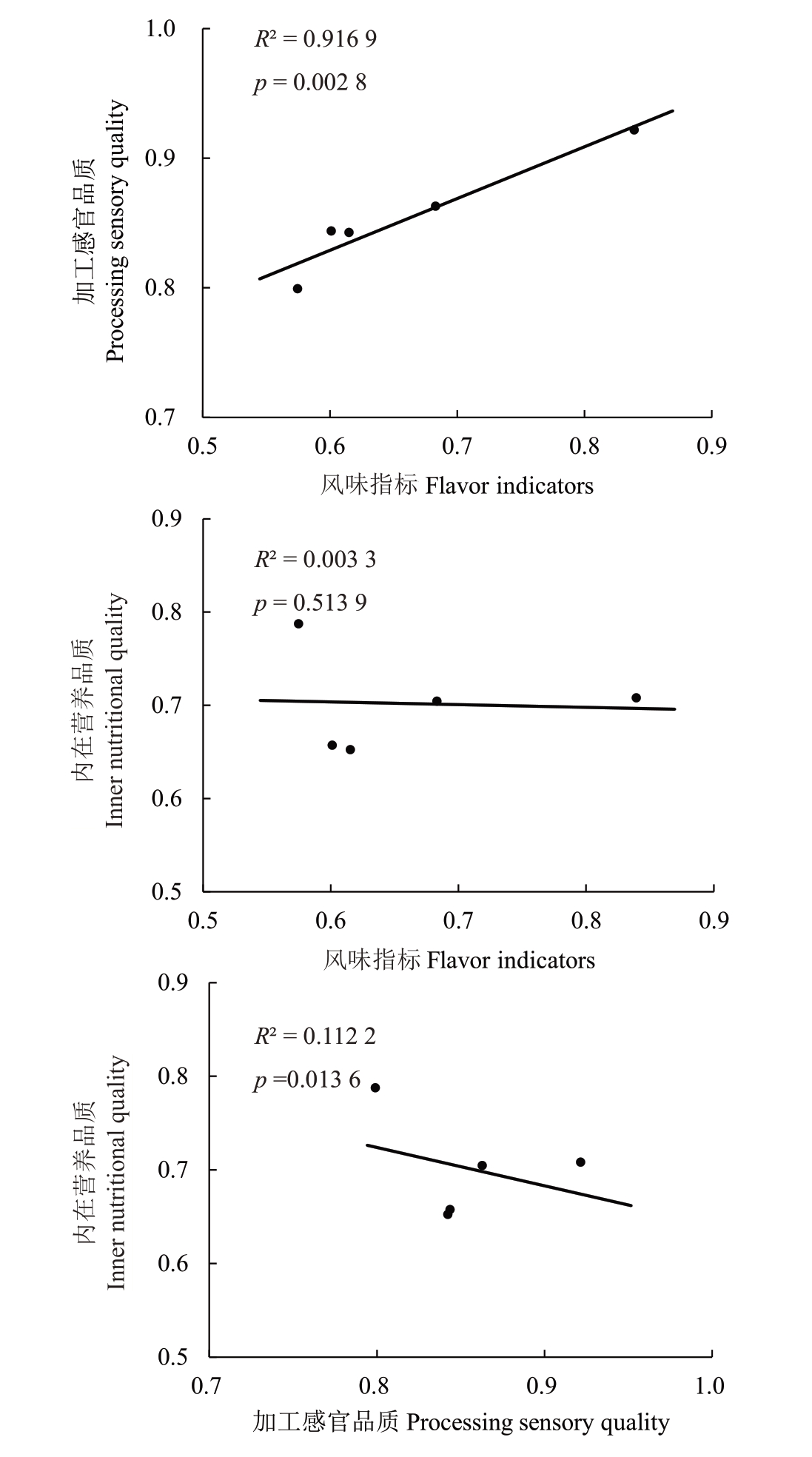
图2 香榧种仁风味指标、内在营养指标和加工感官品质的关系
Fig.2 Relations among kernel flavor indicators,inner nutritional indicators and processing sensory quality of T.grandis
3 讨 论
本研究结果表明,浙江省香榧栽培立地土壤类型丰富且养分特征差异较大,不同类型土壤pH 值、有机质和矿质元素含量的变异系数在19.02%~177.20%之间,土壤水解性氮、有效磷和速效钾含量普遍较高,如除花岗岩风化土外,各土壤的速效钾含量普遍超过140 mg·kg-1,这与前期对香榧林地土壤养分的总体调查结果类似[31-32]。此外,从土壤养分特征指标间的相关性分析可以看出,土壤pH 值与钙、镁、锌元素以及有机质和水解性氮含量均呈显著正相关(p <0.05),表明土壤酸碱度是影响钙、镁、锌等矿质元素供给能力的重要因素,增加香榧林地有机质对提高土壤水解性氮含量具有积极的作用[33]。
在香榧种仁品质性状方面,种仁含油率和蛋白质、水解氨基酸含量的变异系数较低,而种仁淀粉、可溶性糖、矿质元素含量和维生素E 含量的变异系数较高,表明土壤养分特征对种仁淀粉、可溶性糖、矿质元素和维生素E含量的影响较大。本研究中的相关性分析也表明,土壤有机质含量与种仁淀粉、可溶性糖含量呈显著正相关(相关系数分别为0.902和0.893),这可能与有机质能改善土壤结构和微生物环境、促进营养吸收有关[34-35]。此外,土壤矿质元素和种仁矿质元素含量间也存在显著相关关系,如土壤有效磷含量与香榧种仁钙、铁元素含量呈显著正相关,这可能与土壤有效磷通常以钙-磷、铁-磷结合态存在和植物协同吸收有关[36-38]。
不同类型土壤香榧种仁品质的灰色关联度评价结果表明,砂土上种植的香榧在风味指标(排名第1)、内在营养指标(排名第2)和加工感官品质(排名第1)3个方面综合表现较好。韩宁林等[39]前期的调查也认为,石砾含量低于30%的砂质土壤最适宜香榧种植,这可能与砂土质地疏松、通气性好、适于香榧肉质根系的生长有关。但是,砂土容易存在有机质、氮和有效磷不足的情况,应注意加强施肥管理。相较砂土,黄泥土养分含量丰富[17],虽然有利于香榧的树体生长和丰产性,但其上栽培的香榧种仁品质和风味并不突出,这可能与土壤黏性、养分含量构成以及区域气候等有关。
此外,果实品质形成成分通常会影响其风味[40-42]。虽然香榧种仁淀粉含量、可溶性蛋白含量、含油率及各脂肪酸组分在采后后熟过程中会发生变化和转化[43],但种仁风味指标和加工感官品质仍呈显著正相关关系,从得分排序上来看二者也基本一致。因此,香榧种仁含油率和蛋白质、水解氨基酸、淀粉、可溶性糖含量可作为灰色系统关联度分析的量化指标用于评判香榧的加工感官品质。
笔者在本研究中调查的不同土壤类型分布于不同地区,海拔和降雨量等生态因子存在差异,这也可能会对香榧的品质性状产生影响,但生态因子和土壤条件对香榧品质性状的交互作用影响仍不清楚,需要进一步研究。在土壤研究养分特征方面,本研究结果基本上反映了不同母岩发育土壤的差异,但土壤经营管理措施也会一定程度上影响土壤养分含量。因此,今后的研究还需进一步明确各类型土壤养分特征对不同经营管理水平的响应规律,从而为指导香榧林地高效养分管理提供借鉴和指导。
4 结 论
不同母岩发育土壤上栽培的香榧种仁品质特征差异较大,其中种仁含油率和蛋白质、水解氨基酸含量相对稳定,而淀粉、可溶性糖、矿质元素和维生素E 含量的变异系数相对较高;土壤有机质与种仁淀粉、可溶性糖含量,土壤矿质元素和种仁矿质元素含量间均存在显著相关关系;砂土上种植的香榧综合品质最佳;种仁含油率和蛋白质、水解氨基酸、淀粉、可溶性糖含量可作为灰色关联度分析的量化指标用于评判香榧的加工感官品质。
[1] 黎章矩,戴文圣.中国香榧[M].北京:科学出版社,2007:1-5.LI Zhangju,DAI Wensheng. Torreya grandis in China[M]. Beijing:Science Press,2007:1-5.
[2] 黎章矩,骆成方,程晓建,冯肖军,俞卫武.香榧种子成分分析及营养评价[J].浙江林学院学报,2005,22(5):540-544.LI Zhangju,LUO Chengfang,CHENG Xiaojian,FENG Xiaojun,YU Weiwu.Component analysis and nutrition evaluation of seeds of Torreya grandis‘Merrillii’[J].Journal of Zhejiang Forestry College,2005,22(5):540-544.
[3] 李红,张露,刘延奇,贾亚娟,郑玉冠.香榧子油的理化性质及脂肪酸组成分析[J].中国粮油学报,2012,27(5):65-69.LI Hong,ZHANG Lu,LIU Yanqi,JIA Yajuan,ZHENG Yuguan.Analysis on physicochemical properties and fatty acid composition of Torreya grandis oil[J]. Journal of the Chinese Cereals and Oils Association,2012,27(5):65-69.
[4] 于美,张川,曾茂茂,何志勇,陈洁.香榧坚果中油脂和蛋白质的研究进展[J].食品科学,2016,37(17):252-256.YU Mei,ZHANG Chuan,ZENG Maomao,HE Zhiyong,CHEN Jie. Recent advances in research on oils and proteins from Torreya grandis nuts[J].Food Science,2016,37(17):252-256.
[5] 朱杰丽,柴振林,吴翠蓉,黄忆婷,吴勋娅.浙江省香榧及其油脂综合性状研究[J].中国粮油学报,2019,34(3):67-73.ZHU Jieli,CHAI Zhenlin,WU Cuirong,HUANG Yiting,WU Xunya. Comprehensive research on the quality of Torreya grandis and its oil in Zhejiang province[J].Journal of the Chinese Cereals and Oils Association,2019,34(3):67-73.
[6] HE Z Y,ZHU H D,LI W L,ZENG M M,WU S F,CHEN S W,QIN F,CHEN J. Chemical components of cold pressed kernel oils from different Torreya grandis cultivars[J]. Food Chemistry,2016,209:196-202.
[7] 徐超,王鸿飞,邵兴锋,俞雯雯.香榧子油抗氧化活性及降血脂功能研究[J].中国粮油学报,2012,27(8):43-47.XU Chao,WANG Hongfei,SHAO Xingfeng,YU Wenwen.Study on antioxidant activity and reducing blood fat function of Kaga oil[J]. Journal of the Chinese Cereals and Oils Association,2012,27(8):43-47.
[8] 李兴飞,郜海燕,陈杭君,房祥军,葛林梅.香榧坚果生物活性成分与抗氧化研究进展[J].食品科学,2012,33(7):341-345.LI Xingfei,GAO Haiyan,CHEN Hangjun,FANG Xiangjun,GE Linmei. Recent advances in research on bioactive compounds and antioxidant activity of Torreya grandis[J]. Food Science,2012,33(7):341-345.
[9] YU Y J,NI S,WU F,SANG W G. Chemical composition and antioxidant activity of essential oil from Torreya grandis cv.Merrillii arils[J]. Journal of Essential Oil-Bearing Plants,2016,19(5):1170-1180.
[10] YU M,ZENG M M,QIN F,HE Z Y,CHEN J.Physicochemical and functional properties of protein extracts from Torreya grandis seeds[J].Food Chemistry,2017,227:453-460.
[11] 黎章矩,程晓建,戴文圣,曾燕如.香榧品种起源考证[J].浙江林学院学报,2005,22(4):443-448.LI Zhangju,CHENG Xiaojian,DAI Wensheng,ZENG Yanru.Origin of Torreya grandis‘Merrillii’[J]. Journal of Zhejiang Forestry College,2005,22(4):443-448.
[12] 关军锋.果实品质生理[M].北京:科学出版社,2008:5-12.GUAN Junfeng. Fruit quality and physiology[M]. Beijing:Science Press,2008:5-12.
[13] 李瑞芳.微量元素对香榧产量品质的影响[D].杭州:浙江农林大学,2014.LI Ruifang. Effect of trace elements on nut yield and quality in Torreya grandis[D]. Hangzhou:Zhejiang A & F University,2014.
[14] 黄其颖,王飞高,赵元军,李瑞芳,胡杨勇,张春苗,赵科理,储开江,吴家胜,叶正钱.硼锌铜钼配施对香榧生长和果实产量及品质的影响[J].经济林研究,2015,33(3):33-38.HUANG Qiying,WANG Feigao,ZHAO Yuanjun,LI Ruifang,HU Yangyong,ZHANG Chunmiao,ZHAO Keli,CHU Kaijiang,WU Jiasheng,YE Zhengqian. Effects of boron,zinc,copper and molybdenum fertilizers on plant growth,nut yield and nut quality in Torreya grandis[J]. Nonwood Forest Research,2015,33(3):33-38.
[15] 戴文圣,黎章矩,程晓建,喻卫武,符庆功. 香榧林地土壤养分、重金属及对香榧子成分的影响[J].浙江林学院学报,2006,23(4):393-399.DAI Wensheng,LI Zhangju,CHENG Xiaojian,YU Weiwu,FU Qinggong. Mineral elements in Torreya grandis‘Merrillii’seeds and their forest soils[J]. Journal of Zhejiang Forestry College,2006,23(4):393-399.
[16] 孙小红,王国夫,杜轶君,胡绍泉,葛建.绍兴香榧坚果品质变异分析及综合评价[J].食品科学,2018,39(3):129-134.SUN Xiaohong,WANG Guofu,DU Yijun,HU Shaoquan,GE Jian. Variation analysis and comprehensive evaluation of nut quality of Torreya grandis‘Merrillii’from Shaoxing[J]. Food Science,2018,39(3):129-134.
[17] 张才德,杨水章,严月英,陆景冈.香榧林地土壤条件的初步研究[J].土壤通报,1987,18(4):170-172.ZHANG Decai,YANG Shuizhang,YAN Yueying,LU Jinggang.Preliminary study on soil conditions of Torreya grandis forest land[J].Chinese Journal of Soil Science,1987,18(4):170-172.
[18] 国家食品药品监督管理局,中华人民共和国国家卫生和计划生育委员会. 食品安全国家标准食品中脂肪的测定:GB 5009.6—2016[S].北京:中国标准出版社,2016.China Food and Drug Administration,National Health and Family Planning Commission. National food safety standard—Determination of fat in foods:GB 5009.6—2016[S]. Beijing:Standards Press of China,2016.
[19] 国家食品药品监督管理局,中华人民共和国国家卫生和计划生育委员会.食品安全国家标准食品中维生素A、D、E 的测定:GB 5009.82—2016[S].北京:中国标准出版社,2016.China Food and Drug Administration,National Health and Family Planning Commission. National food safety standard—Determination of vitamin A,D,E in foods:GB 5009.82—2016[S].Beijing:Standards Press of China,2016.
[20] 国家食品药品监督管理局,中华人民共和国国家卫生和计划生育委员会. 食品安全国家标准食品中氨基酸的测定:GB 5009.124—2016[S].北京:中国标准出版社,2016.China Food and Drug Administration,National Health and Family Planning Commission. National food safety standard—Determination of amino acids in foods:GB 5009.124—2016[S]. Beijing:Standards Press of China,2016.
[21] 国家食品药品监督管理局,中华人民共和国国家卫生和计划生育委员会. 食品安全国家标准食品中蛋白质的测定:GB 5009.5—2016[S].北京:中国标准出版社,2016.China Food and Drug Administration,National Health and Family Planning Commission. National food safety standard—Determination of protein in foods:GB 5009.5—2016[S]. Beijing:Standards Press of China,2016.
[22] 国家食品药品监督管理局,中华人民共和国国家卫生和计划生育委员会. 食品安全国家标准食品中多元素的测定:GB 5009.268—2016[S].北京:中国标准出版社,2016.China Food and Drug Administration,National Health and Family Planning Commission. National food safety standard—Determination of multi-elements in foods:GB 5009.268—2016[S].Beijing:Standards Press of China,2016.
[23] 国家林业局.森林土壤pH 值的测定:LY/T 1239—1999[S].北京:中国标准出版社,1999.State Forestry Administration.Determination of pH value in forest soil:LY/T 1239—1999[S]. Beijing:Standards Press of China,1999.
[24] 国家林业局.森林土壤氮的测定:LY/T 1228—2015[S].北京:中国标准出版社,2015.State Forestry Administration. Nitrogen determination methods of forest soils:LY/T 1228—2015[S].Beijing:Standards Press of China,2015.
[25] 国家林业局.森林土壤磷的测定:LY/T 1232—2015[S].北京:中国标准出版社,2015.State Forestry Administration. Phosphorus determination methods of forest soils:LY/T 1232—2015 [S]. Beijing:Standards Press of China,2015.
[26] 国家林业局.森林土壤钾的测定:LY/T 1234—2015[S].北京:中国标准出版社,2015.State Forestry Administration. Potassium determination methods of forest soils:LY/T 1234—2015 [S]. Beijing:Standards Press of China,2015.
[27] 国家林业局.森林土壤有机质的测定及碳氮比的计算:LY/T 1237—1999[S].北京:中国标准出版社,1999.State Forestry Administration. Determination of organic matter in forest soil and calculation carbon-nitrogen ratio:LY/T 1237—1999[S].Beijing:Standards Press of China,1999.
[28] 中国人民共和国农业部. 土壤全量钙、镁、钠的测定:NY/T296—1995[S]北京:中国标准出版社,1995.Ministry of Agriculture of the People’s Republic of China. Determination of full-volume calcium,magnesium and sodium in soil:NY/T 296—1995 [S]. Beijing:Standards Press of China,1995.
[29] 生态环境部.土壤和沉积物铜、锌、铅、镍、铬的测定火焰原子吸收分光光度法:HJ 491—2019 [S]. 北京:中国环境出版集团,2019.Ministry of Ecological Environment. Soil and sediment—Determination of copper,zinc,lead,nickel and chromium—Flame atomic absorption spectrophotometry:HJ 491—2019[S]. Beijing:China Environmental Science Press,2019.
[30] 赵春波,宋述尧,陈姗姗,王超楠,张越,温涛.基于灰色系统理论对黄瓜营养品质的评价[J].西北农林科技大学学报(自然科学版),2015,43(11):181-186.ZHAO Chunbo,SONG Shuyao,CHEN Shanshan,WANG Chaonan,ZHANG Yue,WEN Tao. Evaluation of cucumber nutritional quality based on grey system theory[J]. Journal of Northwest A& F University (Nature Science Edition),2015,43(11):181-186.
[31] 戴文圣,黎章矩,程晓建,喻卫武,符庆功.香榧林地土壤养分状况的调查分析[J].浙江林学院学报,2006,23(2):140-144.DAI Wensheng,LI Zhangju,CHENG Xiaojian,YU Weiwu,FU Qinggong. Soil nutrients in Torreya grandis‘Merrillii’plantation[J]. Journal of Zhejiang Forestry College,2006,23(2):140-144.
[32] 董佳琦,张勇,傅伟军,刘海英,王增,吕联江,谢秉楼,蒋仲龙.香榧主产区林地土壤养分空间异质性及其肥力评价[J].生态学报,2021,41(6):2292-2304.DONG Jiaqi,ZHANG Yong,FU Weijun,LIU Haiying,WANG Zeng,LÜ Lianjiang,XIE Binglou,JIANG Zhonglong. Spatial variation of soil nutrients and evaluation of integrated soil fertility in Torreya grandis cv.Merrillii region[J].Acta Ecologica Sinica,2021,41(6):2292-2304.
[33] 李东,王子芳,郑杰炳,高明.紫色丘陵区不同土地利用方式下土壤有机质和全量氮磷钾含量状况[J].土壤通报,2009,40(2):310-314.LI Dong,WANG Zifang,ZHENG Jiebing,GAO Ming. Contents of soil organic matter,nitrogen,phosphorus and potassium under different land-use patterns in purple hill area[J]. Chinese Journal of Soil Science,2009,40(2):310-314.
[34] 夏燕飞,张文会,沈向,毛志泉,胡艳丽.有机质对苹果园土壤改良及对果实产量品质的影响[J]. 北方园艺,2012(21):177-180.XIA Yanfei,ZHANG Wenhui,SHEN Xiang,MAO Zhiquan,HU Yanli. Effects of soil organic matter on soil characteristics and fruit production and quality in apple orchard[J]. Northern Horticulture,2012(21):177-180.
[35] 赵景景.不同土壤有机质水平对苹果叶片光合、果实糖酸代谢及品质的影响[D].杨凌:西北农林科技大学,2018.ZHAO Jingjing. Effects of different levels of organic matter on photosynthesis of leaves,sugar and organic acid metabolism as well as quality in apple fruit[D]. Yangling:Northwest A & F University,2018.
[36] 张林,吴宁,吴彦,罗鹏,刘琳,陈文年,胡红宇.土壤磷素形态及其分级方法研究进展[J].应用生态学报,2009,20(7):1775-1782.ZHANG Lin,WU Ning,WU Yan,LUO Peng,LIU Lin,CHEN Wennian,HU Hongyu. Soil phosphorus form and fractionation scheme:A review[J]. Chinese Journal of Applied Ecology,2009,20(7):1775-1782.
[37] 沈浦,吴正锋,王才斌,孙学武,郑亚萍,于天一,郑永美,陈殿绪,孙秀山,罗盛. 花生钙营养效应及其与磷协同吸收特征[J].中国油料作物学报,2017,39(1):85-90.SHEN Pu,WU Zhengfeng,WANG Caibin,SUN Xuewu,ZHENG Yaping,YU Tianyi,ZHENG Yongmei,CHEN Dianxu,SUN Xiushan,LUO Sheng.Calcium nutrition function in peanut and its synergistic absorption characteristics with phosphorus[J].Chinese Journal of Oil Crop Sciences,2017,39(1):85-90.
[38] 王金路,陈永忠,张党权,陈隆升,彭邵锋.不同磷源对油茶幼苗生长的影响[J].中南林业科技大学学报,2014,34(5):47-50.WANG Jinlu,CHEN Yongzhong,ZHANG Dangquan,CHEN Longsheng,PENG Shaofeng. Effects of different Phosphates on growth of Camellia oleifera seedling[J]. Journal of Central South University of Forestry&Technology,2014,34(5):47-50.
[39] 韩宁林,王东辉.香榧栽培技术[M].北京:中国农业出版社,2006:58.HAN Ninglin,WANG Donghui. Cultivation techniques of Torreya grandis[M].Beijing:China Agriculture Press,2006:58.
[40] 贾惠娟,冈本五郎,平野健.桃果实品质形成成分与其风味之间的相关性[J].果树学报,2004,21(1):5-10.JIA Huijuan,OKAMOTO Goro,HIRANO Ken. Studies on sensory evaluation of juice constituents of peach fruit[J]. Journal of Fruit Science,2004,21(1):5-10.
[41] 李宝江,林桂荣,刘凤君.矿质元素含量与苹果风味品质及耐贮性的关系[J].果树科学,1995,12(3):141-145.LI Baojiang,LIN Guirong,LIU Fengjun. Relationship between fruit quality,storability and mineral composition of apples[J].Journal of Fruit Science,1995,12(3):141-145.
[42] 王海波,李林光,陈学森,李慧峰,杨建明,刘嘉芬,王超.中早熟苹果品种果实的风味物质和风味品质[J].中国农业科学,2010,43(11):2300-2306.WANG Haibo,LI Linguang,CHEN Xuesen,LI Huifeng,YANG Jianming,LIU Jiafen,WANG Chao. Flavor compounds and flavor quality of fruits of mid-season apple cultivars[J]. Scientia Agricultura Sinica,2010,43(11):2300-2306.
[43] 单燕飞,王为宇,项伟霞,宋丽丽,周敏樱,陈嘉伟,索金伟,喻卫武,吴家胜,胡渊渊.堆沤温度对后熟过程中榧籽主要营养物质变化的影响[J].林业科学,2019,55(7):46-56.SHAN Yanfei,WANG Weiyu,XIANG Weixia,SONG Lili,ZHOU Minying,CHEN Jiawei,SUO Jinwei,YU Weiwu,WU Jiasheng,HU Yuanyuan. Effect of retting temperature on transformation of main nutrients in seeds of different Torreya grandis cultivars during after-ripening period[J].Scientia Silvae Sinicae,2019,55(7):46-56.